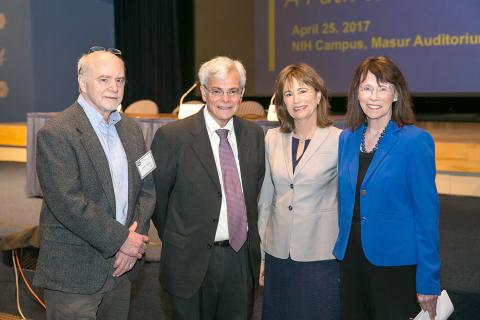NINR Intramural Program Holds Scientific Symposium

Photo: Chia-Chi Charlie Chang
NINR’s Intramural Research Program (IRP) recently hosted a scientific symposium—Symptom Science Research: A Path to Precision Health—on campus. It highlighted NINR’s intramural scientific advances and collaborations across NIH and other organizations. Several hundred scientists, health care professionals, students and members of the public attended the event either in person or via live video streaming.
NINR director Dr. Patricia Grady opened the event, noting that “the NINR Division of Intramural Research has built a strong scientific program by supporting research conducted on the Bethesda campus that focuses primarily on understanding the underlying biological mechanisms of a range of symptoms, their effect on patients and how patients respond to interventions.”
Presenting the keynote address, NIH deputy director for intramural research Dr. Michael Gottesman set the tone of the day by reflecting on the history of NINR, including its founding as the National Center for Nursing Research and its transition to an NIH institute. Gottesman noted NINR’s collaborations with other ICs to examine the link between disease and care, highlighting the institute’s work in partnership with NIAID managing the care of people with AIDS and with NCI addressing symptom management in cancer patients.
Three scientific panels, moderated by investigators from NINR’s IRP, brought together experts to discuss their research on the gut-liver-brain axis, fatigue and brain injury.

Photo: Chia-Chi Charlie Chang
The first of the day’s three panels focused on the role of the gut-liver-brain axis on inflammation, addiction and infection. Dr. Wendy Henderson moderated and was joined by Dr. Colleen Hadigan (NIAID) and Dr. Lorenzo Leggio (NIAAA/NIDA).
Dr. Leorey Saligan moderated the second panel and examined the role of inflammatory and glutamatergic pathways on fatigue. He was joined by Dr. John O’Shea (NIAMS) and Dr. Carlos Zarate, Jr. (NIMH).
Closing out the symposium, Dr. Jessica Gill moderated the final panel, which explored the identification of biomarkers to potentially improve the care of patients with brain injuries. She was joined by Dr. Dimitrios Kapogiannis (NIA) and Dr. Robert Stern (Boston University School of Medicine).
The symposium included a poster session, highlighting research conducted by NINR’s intramural fellows and trainees along with collaborating scientists from the NIH community.
After the scientific presentations and discussions, NINR scientific director Dr. Ann Cashion closed the day, noting that it was “a wonderful demonstration of collaboration among multiple disciplines and multiple investigators, all working in the area of clinical research, hoping to find treatments and interventions that will actually improve patient care and patient outcomes.”
To view the full symposium, visit https://videocast.nih.gov/summary.asp?Live=21623&bhcp=1.
